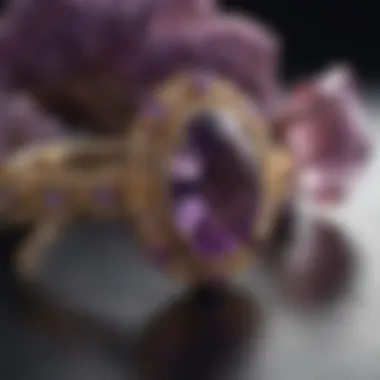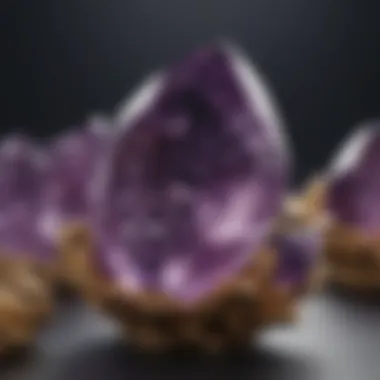Unraveling the Fascinating Realm of Amethyst Crystal Pricing


Rock and Fossil Identificantion
When looking at amethyst crystals, it is crucial to identify their unique characteristics that set them apart from other rocks and minerals. Amethyst, a type of quartz, is renowned for its rich purple hue and distinctive crystal structure. To distinguish real amethyst from imitations, one needs to observe its color saturation, transparency, and any natural inclusions within the crystal. It is recommended to use tools like a magnifying glass and UV light to aid in the identification process.
Rock Quality Assessment
In the realm of amethyst crystals, assessing the quality of the rock is paramount in determining its market value. Factors such as color intensity, clarity, and size significantly influence the price of amethyst. High-quality amethyst typically displays a deep purple color with excellent transparency, devoid of any visible inclusions. Collectors and buyers often seek crystals with vibrant color saturation and uniformity.
Pricing Factors
Various elements contribute to the pricing of amethyst crystals. Rarity, color saturation, clarity, and carat weight all play a role in determining the value of these mesmerizing gemstones. Additionally, the source of the crystal, mining conditions, and any enhancements or treatments it has undergone can impact its price. Understanding these pricing factors is crucial for both buyers and sellers in the transparent trade of amethyst crystals.
Introduction
The realm of amethyst crystals is a fascinating domain steeped in allure and mystique. As we embark on this journey to uncover the intricate details that dictate the real amethyst crystal price, we find ourselves delving into a world where beauty, rarity, and value intertwine seamlessly. This article serves as a guiding beacon, shedding light on the multifaceted aspects that underpin the pricing dynamics of these mesmerizing gemstones. From unraveling the factors that influence their value to offering indispensable insights for potential buyers and avid collectors, we aim to demystify the nuances of amethyst crystal pricing with meticulous attention to detail.
Understanding Amethyst Crystals
The Origins of Amethyst
Within the vast tapestry of gemstones, the allure of amethyst shines brightly, its origins weaving a tale of geological marvel. Originating from diverse locales across the globe, amethyst captivates with its striking hues and unique formations. The genesis of amethyst traces back to ancient volcanic activity, where the interplay of minerals and temperatures birthed these exquisite crystals. This geological heritage lends amethyst a distinct character, making it a sought-after choice for discerning collectors and enthusiasts. Despite its geological splendor, the complexity of amethyst's origins poses both opportunities and challenges in the realm of crystal pricing.
Physical Characteristics of Amethyst
Exploring the physical manifestations of amethyst unveils a world of breathtaking beauty and sophistication. Renowned for its captivating purple hues ranging from delicate lilacs to rich violets, amethyst exudes an aura of elegance that transcends time. The crystalline structure of amethyst, marked by intricate patterns and inclusions, adds a touch of individuality to each specimen. These physical traits not only enhance the visual appeal of amethyst but also contribute significantly to its overall value in the market. While the transparency and clarity of amethyst crystals serve as benchmarks for quality, the presence of characteristic inclusions can at times add a touch of uniqueness that appeals to connoisseurs worldwide.
Significance of Amethyst
Spiritual and Metaphysical Properties
Steeped in a rich tapestry of spiritual lore, amethyst has long been revered for its metaphysical properties. Believed to possess healing energies and protective powers, amethyst holds a special place in various ancient and contemporary spiritual practices. Its calming presence and ability to instill clarity of thought are among the key attributes that contribute to its significance in the realm of spirituality. The intrinsic connection between amethyst and the metaphysical realm underscores its timeless allure, making it a gemstone of profound symbolism and emotional resonance.
Historical and Cultural Relevance
Embedded within the annals of history and culture, amethyst emerges as a gemstone of enduring significance. From ancient civilizations to modern societies, amethyst has left an indelible mark on human culture, symbolizing elegance, wisdom, and spiritual enlightenment. Its association with royalty and divine wisdom further elevates its cultural importance, positioning it as a gemstone of regal splendor. The historical journey of amethyst through varied cultures and epochs speaks volumes about its timeless appeal and cultural resonance, enriching its status as a gemstone of unparalleled historical and cultural relevance.


Factors Influencing Real Amethyst Crystal Price
Understanding the factors that impact the pricing of real amethyst crystals is crucial in the realm of gemology. These factors play a pivotal role in determining the value and desirability of these exquisite crystals. By delving into elements such as color, clarity, cut, carat weight, origin, and rarity, one can unravel the intricate nuances that contribute to the pricing dynamics of amethyst crystals. Analyzing these factors helps both buyers and collectors make informed decisions, ensuring they get the most value for their investment.
Color and Clarity
Color and clarity are fundamental factors that heavily influence the pricing of amethyst crystals. The interplay of hue, tone, and saturation determines the visual appeal and overall quality of the crystal. A vibrant hue with appropriate tone and saturation levels enhances the gem's beauty and value. On the other hand, any inclusions or impurities can diminish the clarity and impact the crystal's brilliance. Understanding these aspects enables buyers to discern quality variations and make educated choices when acquiring amethyst crystals.
Role of Hue, Tone, and Saturation
The color spectrum of amethyst, ranging from light lavender to deep purple, is a hallmark of its allure. Balancing the hue, tone, and saturation is essential in showcasing the crystal's inherent beauty. Optimal combination results in a visually captivating gem that commands higher prices due to its rarity and aesthetic appeal within the market.
Impact of Inclusions on Value
Inclusions, natural features within the crystal, can affect its clarity and overall value. Crystals with minimal inclusions are deemed more valuable and fetch premium prices in the market. Buyers often prioritize amethyst crystals with high clarity levels, as they signify superior quality and purity.
Cut and Carat Weight
The cut and carat weight of an amethyst crystal are key determinants of its visual appeal and market value. Different cutting styles accentuate the crystal's natural characteristics, while carat weight indicates its size and rarity within the gemstone industry.
Popular Shapes and Cutting Styles
Various cutting styles, such as brilliant cut, emerald cut, and pear cut, highlight different facets of the amethyst crystal, amplifying its brilliance and color intensity. Each shape offers a distinctive aesthetic, catering to diverse preferences among buyers and collectors.
Understanding Carat Weight
Carat weight signifies the size and rarity of the amethyst crystal. Larger crystals with higher carat weights are rarer and consequently command higher prices in the market. Understanding carat weight enables buyers to assess the value proposition of a crystal based on its size and scarcity.
Origin and Rarity
The origin and rarity of an amethyst crystal play a significant role in determining its market value and desirability among collectors. Evaluating the source and scarcity of the crystal provides insights into its uniqueness and historical significance.
Distinguishing Amethyst Sources
Identifying the geographic source of an amethyst crystal, such as Brazil, Uruguay, or Zambia, offers clues about its quality and potential value. Each location produces crystals with distinct characteristics, influencing their market demand and pricing.
Evaluation of Rarity


Assessing the rarity of an amethyst crystal involves studying factors like color intensity, clarity, size, and cut quality. Rare variations of amethyst, such as deep purple hues with exceptional clarity, are prized for their exclusivity and allure, leading to higher price tags in the gemstone market.
Determining Amethyst Crystal Authenticity
Determining Amethyst Crystal Authenticity holds paramount importance in the realm of amethyst crystal pricing due to the market flooded with synthetic counterparts. Understanding its authenticity ensures buyers and collectors obtain genuine pieces of high value. With the proliferation of fake products, emphasizing authenticity becomes a crucial factor in making informed purchase decisions.
The certification and verification processes play a vital role in establishing the authenticity of amethyst crystals. Gemological certificates provide a tangible assurance of the crystal's genuineness, detailing its origin, quality, and characteristics. These certificates serve as a safeguard against fraudulent practices in the gemstone industry, offering buyers peace of mind and confidence in their investment.
Professional appraisal processes further solidify the authenticity of amethyst crystals by involving expert gemologists who assess various characteristics such as color, clarity, and any possible treatments. Through meticulous examination, appraisers determine the true nature of the crystal, providing valuable insight into its quality and market value. Buyers can rely on these appraisals to make well-informed decisions when purchasing amethyst crystals.
Certification and Verification
Importance of Gemological Certificates
The importance of gemological certificates lies in their role as verifiable documents that validate the authenticity and quality of amethyst crystals. These certificates offer detailed information about the gemstone, including its cut, carat weight, and any enhancements present. Gemological certificates act as a form of assurance for buyers, establishing trust and credibility in the purchase process.
Gemological certificates serve as a reliable reference point for both buyers and sellers, facilitating transparent transactions based on accurate gemstone details. By verifying the origin and characteristics of amethyst crystals, these certificates elevate the overall integrity of the gemstone market, ensuring fair value exchanges and avoiding misrepresentations.
Professional Appraisal Processes
Professional appraisal processes contribute significantly to the assessment of amethyst crystal authenticity by employing trained gemologists to evaluate the gemstone's quality and characteristics. Appraisers conduct thorough inspections, utilizing specialized tools to analyze various aspects such as color consistency, inclusions, and transparency.
The key characteristic of professional appraisal processes lies in their ability to provide comprehensive evaluations that go beyond surface observations. By delving into the minute details of amethyst crystals, appraisers deliver precise assessments that account for the gemstone's unique features and market value. This detailed approach enhances the credibility of appraisal reports and enables buyers to make well-informed decisions based on expert insights.
Market Trends and Pricing Strategies
In the realm of real amethyst crystals, understanding market trends and pricing strategies is paramount. Not only does it provide insights into the current landscape of the industry, but it also aids buyers and collectors in making informed decisions regarding their investments. This section delves deep into the dynamic nature of the market, shedding light on crucial factors that shape the pricing of amethyst crystals.
Global Demand and Supply
Factors Driving Market Trends
When it comes to the world of amethyst crystals, several key factors drive market trends. One of the primary elements influencing these trends is the rarity of specific varieties of amethyst. The scarcity of certain shades or types of amethyst can significantly impact their value in the market, leading to fluctuations in prices. Additionally, consumer preferences play a pivotal role in shaping market trends. As trends evolve and consumer tastes shift, the demand for particular types of amethyst crystals may rise or fall accordingly. Understanding these factors is essential for both buyers and sellers to navigate the market effectively.
Shifts in Consumer Preferences
Consumer preferences act as a driving force behind the shifts observed in the market for amethyst crystals. As consumer tastes evolve, so do the trends in the industry. For instance, there may be a rise in demand for ethically sourced amethyst crystals or a growing interest in unique, one-of-a-kind pieces. By staying attuned to these changes, market players can adapt their strategies to meet the evolving demands of consumers effectively. However, these shifts also pose challenges, such as the need for constant innovation to stay ahead of emerging trends.


Investment Value of Amethyst
Amethyst as a Collectible Asset
One intriguing aspect of amethyst crystals is their potential as a collectible asset. For avid collectors, owning rare or exceptional pieces of amethyst can hold both sentimental and investment value. The allure of building a curated collection of these unique gemstones adds a layer of excitement for enthusiasts. Moreover, the aesthetics and metaphysical properties of amethyst further enhance its appeal as a collectible asset. However, collectors must be mindful of factors such as authenticity and provenance to ensure the long-term value of their collections.
Economic Considerations for Investors
For investors considering amethyst crystals as a viable asset class, various economic considerations come into play. The stability of the global gemstone market, the potential for growth in demand, and the historical performance of amethyst as an investment are critical factors to assess. Additionally, understanding the tax implications, liquidity constraints, and market volatility associated with investing in amethyst is essential for making informed decisions. By delving into these economic considerations, investors can strategize effectively and maximize the potential returns from their investments.
Buying and Selling Real Amethyst Crystals
In this section, we delve into the intricate world of buying and selling real amethyst crystals. As avid enthusiasts of these captivating gemstones, understanding the process of acquiring and offloading them is crucial. Whether you are a novice collector or a seasoned investor, grasping the dynamics of transactions involving amethyst crystals can significantly impact your overall experience.
Here, we dissect the key elements that distinguish a fair deal in the realm of amethyst trading. From examining the quality of the crystals to evaluating market prices, buyers and sellers alike must navigate a landscape where knowledge and negotiation come hand in hand. By shedding light on the nuances of purchasing and vending amethyst crystals, this article equips you with essential insights to make informed decisions.
Negotiation Tactics
Tips for Securing Fair Deals
Embarking on the journey of acquiring amethyst crystals entails the need for effective negotiation tactics. The art of securing fair deals lies not only in monetary transactions but also in assessing the quality and value of the crystals in question. By honing your negotiation skills, you can ensure that both parties involved benefit equitably from the exchange.
Tips for securing fair deals are pivotal in navigating the nuances of the amethyst market. By understanding the subtle cues of gem quality and market trends, buyers can negotiate prices that reflect the true worth of the crystals. This strategic approach not only fosters fair transactions but also cultivates trust and respect among buyers and sellers.
Haggling Strategies
When exploring the world of amethyst crystal trading, haggling strategies play a vital role in shaping successful transactions. The ability to negotiate prices effectively can lead to mutually beneficial outcomes, where both parties feel satisfied with the deal struck. Haggling is an art form that requires tact, patience, and a keen eye for detail.
Haggling strategies present a nuanced approach to price negotiation, allowing buyers to assert their interests while respecting the perspectives of sellers. Recognizing the value of the crystals and leveraging your knowledge can elevate haggling from a mere bargaining tool to a constructive means of reaching agreements. By mastering haggling strategies, buyers can navigate the intricate terrain of amethyst transactions with confidence and finesse.
Online Platforms and Auction Houses
Popular Websites for Amethyst Sales
In the digital age, online platforms have revolutionized the buying and selling of amethyst crystals. Popular websites dedicated to gemstone sales offer enthusiasts a vast array of choices and the convenience of exploring different options from the comfort of their homes. These platforms serve as virtual marketplaces where buyers and sellers converge to conduct transactions swiftly and securely.
Popular websites for amethyst sales provide a dynamic space for enthusiasts to browse an extensive selection of crystals, compare prices, and connect with sellers from across the globe. The accessibility and transparency offered by these online platforms simplify the process of acquiring rare and exquisite amethyst specimens, catering to a diverse community of collectors and investors.
Advantages of Auctions
Auction houses present a traditional yet effective channel for buying and selling amethyst crystals. The competitive nature of auctions often leads to fair market prices, as bidders determine the value of the crystals through active participation. Auctions offer a platform where rarity and demand converge, influencing the final prices fetched by these precious gemstones.
The advantages of auctions lie in their ability to attract a global audience of collectors and investors, thereby increasing the visibility and desirability of amethyst crystals. By engaging in auctions, buyers can discover unique pieces and access exclusive collections that may not be readily available through other channels. The competitive spirit of auctions adds an element of excitement and intrigue to the process of acquiring amethyst crystals, making it a favored method for enthusiasts seeking exceptional specimens.







